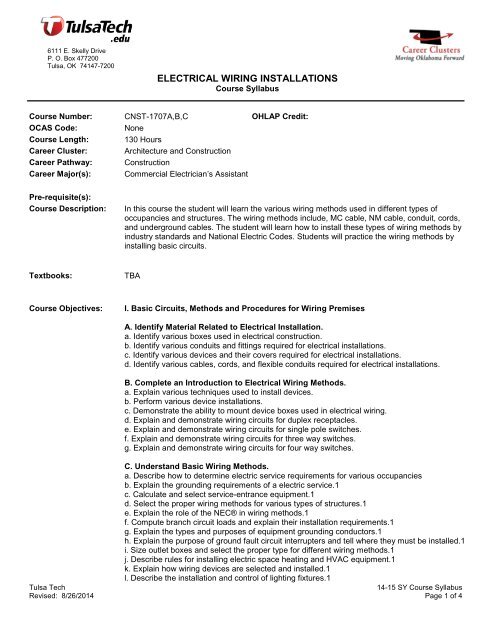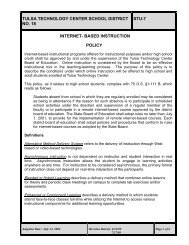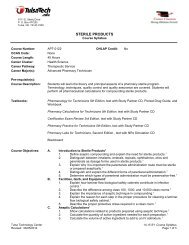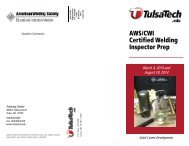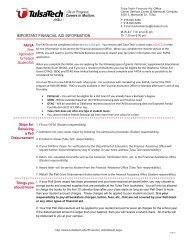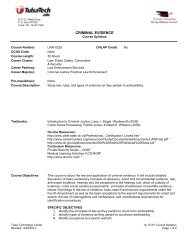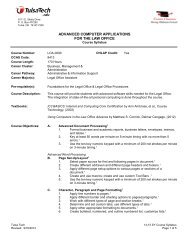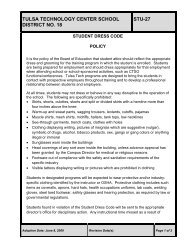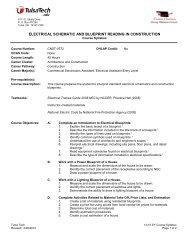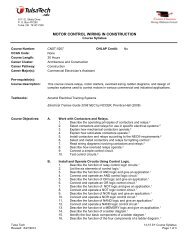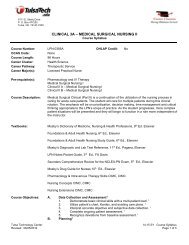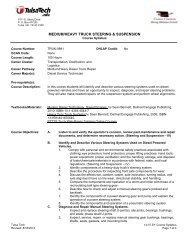Electrical Wiring Installations - Tulsa Technology Center
Electrical Wiring Installations - Tulsa Technology Center
Electrical Wiring Installations - Tulsa Technology Center
Create successful ePaper yourself
Turn your PDF publications into a flip-book with our unique Google optimized e-Paper software.
6111 E. Skelly DriveP. O. Box 477200<strong>Tulsa</strong>, OK 74147-7200ELECTRICAL WIRING INSTALLATIONSCourse SyllabusCourse Number: CNST-1707A,B,C OHLAP Credit:OCAS Code:NoneCourse Length: 130 HoursCareer Cluster: Architecture and ConstructionCareer Pathway: ConstructionCareer Major(s): Commercial Electrician’s AssistantPre-requisite(s):Course Description:In this course the student will learn the various wiring methods used in different types ofoccupancies and structures. The wiring methods include, MC cable, NM cable, conduit, cords,and underground cables. The student will learn how to install these types of wiring methods byindustry standards and National Electric Codes. Students will practice the wiring methods byinstalling basic circuits.Textbooks:TBACourse Objectives:I. Basic Circuits, Methods and Procedures for <strong>Wiring</strong> PremisesA. Identify Material Related to <strong>Electrical</strong> Installation.a. Identify various boxes used in electrical construction.b. Identify various conduits and fittings required for electrical installations.c. Identify various devices and their covers required for electrical installations.d. Identify various cables, cords, and flexible conduits required for electrical installations.B. Complete an Introduction to <strong>Electrical</strong> <strong>Wiring</strong> Methods.a. Explain various techniques used to install devices.b. Perform various device installations.c. Demonstrate the ability to mount device boxes used in electrical wiring.d. Explain and demonstrate wiring circuits for duplex receptacles.e. Explain and demonstrate wiring circuits for single pole switches.f. Explain and demonstrate wiring circuits for three way switches.g. Explain and demonstrate wiring circuits for four way switches.C. Understand Basic <strong>Wiring</strong> Methods.a. Describe how to determine electric service requirements for various occupanciesb. Explain the grounding requirements of a electric service.1c. Calculate and select service-entrance equipment.1d. Select the proper wiring methods for various types of structures.1e. Explain the role of the NEC® in wiring methods.1f. Compute branch circuit loads and explain their installation requirements.1g. Explain the types and purposes of equipment grounding conductors.1h. Explain the purpose of ground fault circuit interrupters and tell where they must be installed.1i. Size outlet boxes and select the proper type for different wiring methods.1j. Describe rules for installing electric space heating and HVAC equipment.1k. Explain how wiring devices are selected and installed.1l. Describe the installation and control of lighting fixtures.1<strong>Tulsa</strong> Tech14-15 SY Course SyllabusRevised: 8/26/2014 Page 1 of 4
ELECTRICAL WIRING INSTALLATIONSD. Identify Receptacles Used in Different Applications.a. Identify various types of receptacles used in residential and commercial installations anddiscuss their purposes.b. Locate code requirements in NEC for receptacles.c. Discuss ground fault circuit interrupter receptacles and their operations.d. Choose correct receptacles by the ampacity of the equipment being connected.e. Identify equipment used to protect receptacles installed in specific environments.E. Complete <strong>Electrical</strong> <strong>Installations</strong>.a. Install the following receptacle circuits:b. Receptaclec. Multi-receptacled. Switched receptaclee. 240v dryer receptaclef. GCFI receptacleg. GCFI Feed Through receptacleh. Weatherproof receptacleF. Demonstrate Knowledge of <strong>Electrical</strong> Switches.a. Identify various types of switches used in residential and commercial installations anddiscuss their purposes.b. Locate code requirements in NEC for switches and lighting outlets.c. Discuss single pole switches and their operations.d. Discuss 3 way switches and their operations.e. Discuss 4 way switches and their operations.f. Identify equipment used to protect switches installed in specific environments.G. Complete <strong>Electrical</strong> <strong>Installations</strong>.a. Install the following switch circuits:b. single pole switchc. dimmerd. multi-lighte. multi-switchf. light first switchH. Complete <strong>Electrical</strong> <strong>Installations</strong>.a. Install the following:b. Three way switch projectc. Light first three-way switchd. Four-way switch projecte. Light first four way switchf. Multi four wayg. Combination Switch and Receptacle CircuitsI. Demonstrate Hand Bending.a. Identify the methods of hand bending conduit.1b. Identify the various methods used to install conduit.1c. Use math formulas to determine conduit bends.1d. Make 90° bends, back-to-back bends, offsets, kicks, and saddle bends using a handbender.1e. Cut, ream, and thread conduit.1J. Understand Raceways, Boxes, and Fittings.a. Describe various types of cable trays and raceways.1b. Identify and select various types and sizes of raceways.1c. Identify and select various types and sizes of cable trays.1<strong>Tulsa</strong> Tech14-15 SY Course SyllabusRevised: 8/26/2014 Page 2 of 4
ELECTRICAL WIRING INSTALLATIONSP. Understand Electric Service.Q. Describe how to determine electric service requirements for dwellings. 1R. Explain the grounding requirements of a residential electric service. 1S. Calculate and select service-entrance equipment.1T. Select the proper wiring methods for various types of residences.1U. Install an Overhead electric service.1V. Install an underground lateral electric service.11 NCCER objectivesTeaching Methods:The class will primarily be taught by the lecture and demonstration method and supported byvarious media materials to address various learning styles. There will be question and answersessions over material covered in lecture and media presentations. Supervised lab time isprovided for students to complete required projects.Grading Procedures:1. Students are graded on theory and shop practice and performance.2. Each course must be passed with seventy (70%) percent or better.3. Grading scale: A=90-100%, B=80-89%, C=70-79%, D=60-69%, F=50-59%.Description ofClassroom,Laboratories, andEquipment:<strong>Tulsa</strong> <strong>Technology</strong> <strong>Center</strong> campuses are owned and operated by <strong>Tulsa</strong> <strong>Technology</strong> <strong>Center</strong>School District No. 18. All programs provide students the opportunity to work withprofessionally certified instructors in modern, well-equipped facilities.AvailableCertifications/College CreditThe student may be eligible to take state, national or industry exam after completion of theprogram. College credit may be issued from Oklahoma State University-Okmulgee or <strong>Tulsa</strong>Community College. See program counselor for additional information.College CreditEligibility:The student must maintain a grade point average of 2.0 or better.<strong>Tulsa</strong> Tech14-15 SY Course SyllabusRevised: 8/26/2014 Page 4 of 4


